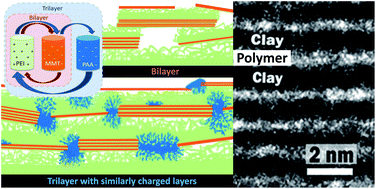High gas barrier imparted by similarly charged multilayers in nanobrick wall thin films†
Abstract
Super oxygen barrier trilayer thin films have been deposited using two successive anionic layers of clay and polymer following every cationic polymer layer during layer-by-layer assembly. Polymer–clay bilayer films show good oxygen barrier properties due to a nanobrick wall structure consisting of clay nanoplatelets within the polymeric mortar. It is shown here that adding an anionic polymer layer reduces free volume of the film by filling in gaps of the similarly charged clay layer and increases the barrier performance over the bilayer configuration by at least one order of magnitude. Highly aligned platelets with some non-continuous clay stacks were imaged at nanometer resolution within the microtomed LbL thin film. The super gas barrier, transparent nanocoatings obtained are useful for a variety of food, pressurized, and flexible electronics packaging applications.


 Please wait while we load your content...
Please wait while we load your content...